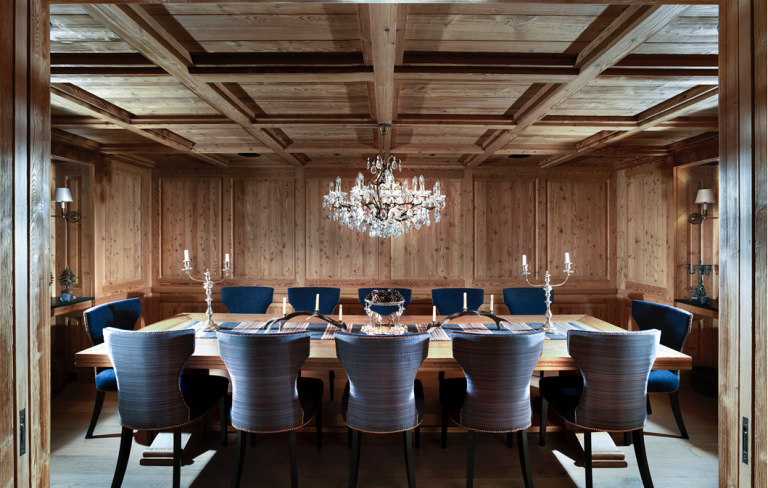The online magazine Luxury Defined from Christie’s International Real Estate shorty presented Rachel Loos’s new book “Art at Home“ in which she reveals everything you ever wanted to know about living with art but were too afraid to ask… The book is considered an accessible guide to collecting and curating art in your home.
According to the article Loos’s relationship with art, and in turn art at home, began some 30 years ago, with a gift of a photographic print entitled Fashion Models in New York taken by the celebrated photographer Norman Parkinson for the British edition of Vogue magazine.

The muted blue tones of this tranquil but engaging hallway perfectly complement the paintings the owner has chosen to display in order to welcome visitors to their home. Image: Dan Duchars
Loos writes: “The picture was a lesson in the power of art, in whatever form, to make a connection, and to this day, photography remains a favorite medium of mine. Slim Aarons’ mid-century photographs of the rich and very beautiful at play, whether lounging by a pool in Hollywood or out on the ski slopes, are a joy to gaze upon—not just for the color and composition, but also for capturing the essence of that time.“

A large statement artwork dominates the focal point of a room and brings it to life, as this abstract painting demonstrates. Image: Polly Wreford
Loos: “It is this that I love about portraits in oils, too, whether it be by Hans Holbein the Younger, Lucian Freud, or Laura Quinn Harris—the ability of the artist to capture a person’s character, prompting us to imagine the sitter’s life and, if they lived in tumultuous times, what they saw and heard.“ She continues: “Today, we understand more than ever how important our home is to our peace of mind, and research has shown that we are happiest when we live in a dwelling that visually represents who we are. Art has never been as accessible as it is right now, as the past few years have seen a sea change in the way it is purchased.“
How to start a Collection
If you haven’t bought art before, how do you begin? How one buys an artwork usually falls into two camps: instinctively—falling in love with a piece and buying it, regardless of whether you have a place planned for it in your home; or practically—buying an artwork for a specific position in your living space.
Either way, it’s best to understand what kind of art you are drawn to, so take the time to do some research. Look at art in galleries, both physical and online—search #emergingartist on Instagram, for example, and you’ll find more than four million posts. Think about what you like and dislike.
Do you love landscapes that transport you to the countryside or the coast, or an abstract print that encourages you to daydream and switch off? Are you attracted to images of the natural world and botanical prints? Once you have an idea of what you do and don’t like, it is easier to buy with confidence, and if you’re buying on impulse, you’re more likely to choose a work that will fit into the decor of your home.
The Mood Matters
When considering an artwork for a room, you need to think about how it will affect the space, especially if it is a statement artwork. Its size will also influence the mood—and a work that is full of color and drama will create an energetic and vibrant feel, whereas one with a more muted palette will help to establish a relaxed atmosphere.
All of this means you need to consider how you want to feel in a space before you choose art for it. A living room, for example, can be enjoyed in many ways. If you wish it to be a place to unwind, it’s best to choose a soothing abstract artwork or a peaceful landscape. If it’s primarily an entertaining space and you wish for a greater sense of energy, opt for an artwork with bolder colors and graphic prints that will lend a room vibrancy. You can also use art to add a touch of playfulness, choosing works that make you smile.
Hanging Your Art at Home
You can hang art on any wall of a room, and even on all of them, but the easiest way to begin is to consider its focal point—where your eye is naturally drawn when you walk in—as this will give you a center from which to start. In a room with a mantelpiece, this will be the wall above it.
Large pieces of furniture can also help give you a focal point: in a living room, it’s often the wall above the couch; in a bedroom, it’s the wall above the headboard. If your space doesn’t have an obvious focal point, opt for the largest empty wall, as hanging art there will draw the eye and allow you to design the rest of the room around it.
Once you have decided on your focal point, look around the space and consider where else you could hang art; the narrow section of wall between windows, perhaps, or above a console, sideboard, or credenza. Behind a door is a lovely way to add an unexpected pop of interest to a room.
However, when populating your walls, ensure you maintain a hierarchy in the artworks so when you walk into a room, your eye still falls to your focal point before traveling around in a way that feels comfortable. If the artworks fight each other for attention, the room could feel unbalanced.
Art at Home Isn’t Just Paintings
Today, you can adorn your walls with all manner of objects, not just traditional artwork. Ceramics, and plates in particular, have come out of the closet and onto walls, and are found not just in kitchens but also in hallways, living rooms, and bathrooms. In fact, the plate wall is a decorative display used by many renowned interior designers, including Kelly Wearstler, who decked the foyer of the Viceroy Hotel Santa Monica with them.
The ever-popular gallery wall has been extended to become a memory wall—a collection that can include art but also objects that reflect moments in your life, such as a ticket to a concert or a map that reminds you of a special place. One of the homes in the book features mounted boxes of shells and sand from places the homeowner has traveled to.
Ready to flex your artistic insticts? Browse properties with gallery space for displaying art at home, and read more from the Spring/Summer 2024 issue of Christie’s International Real Estate magazine here.
Art at Home by Rachel Loos (Ryland Peters & Small) is out now and can be ordered here.




